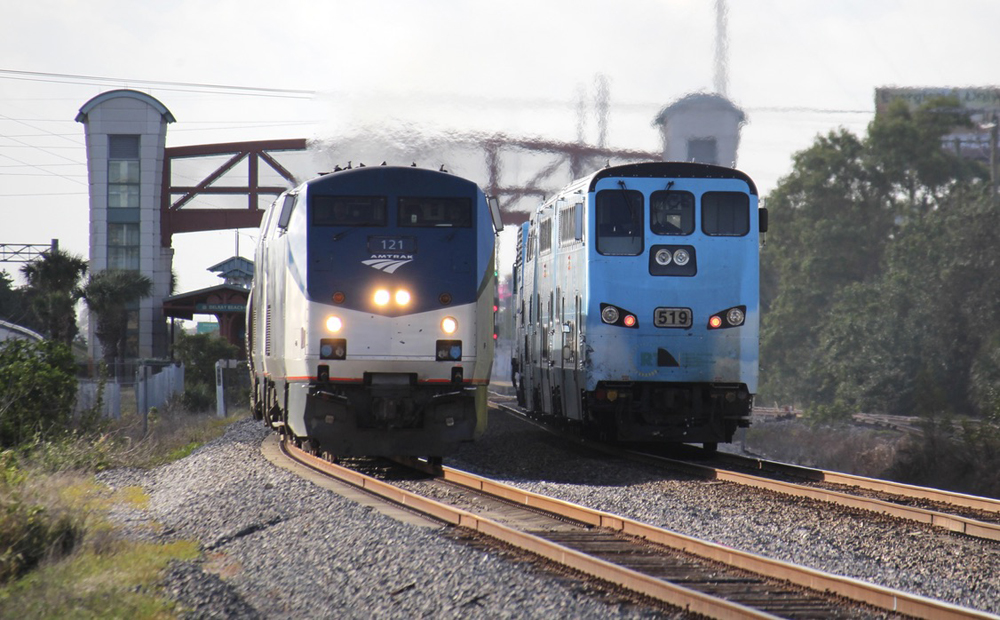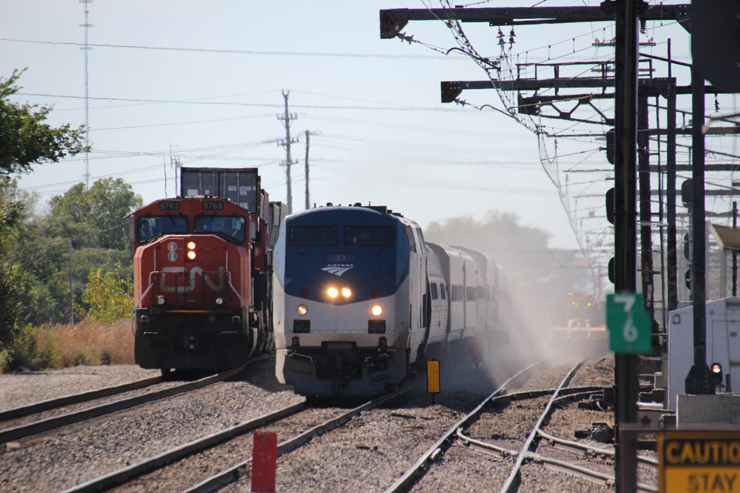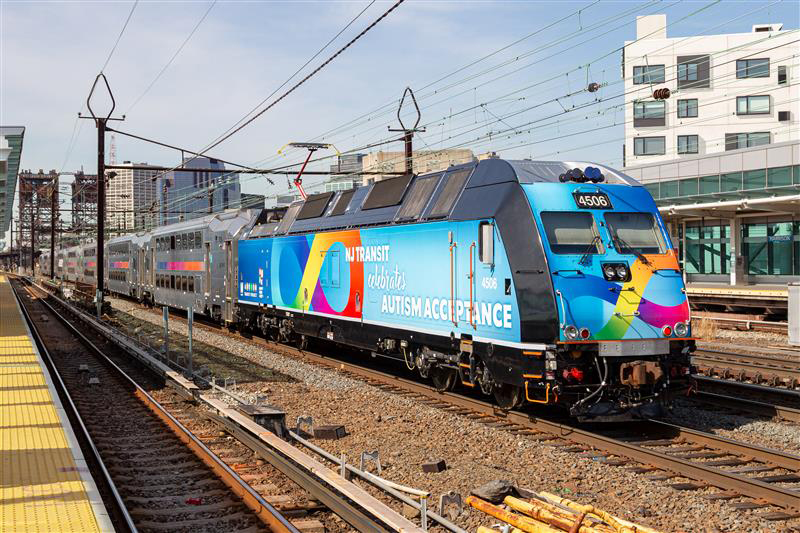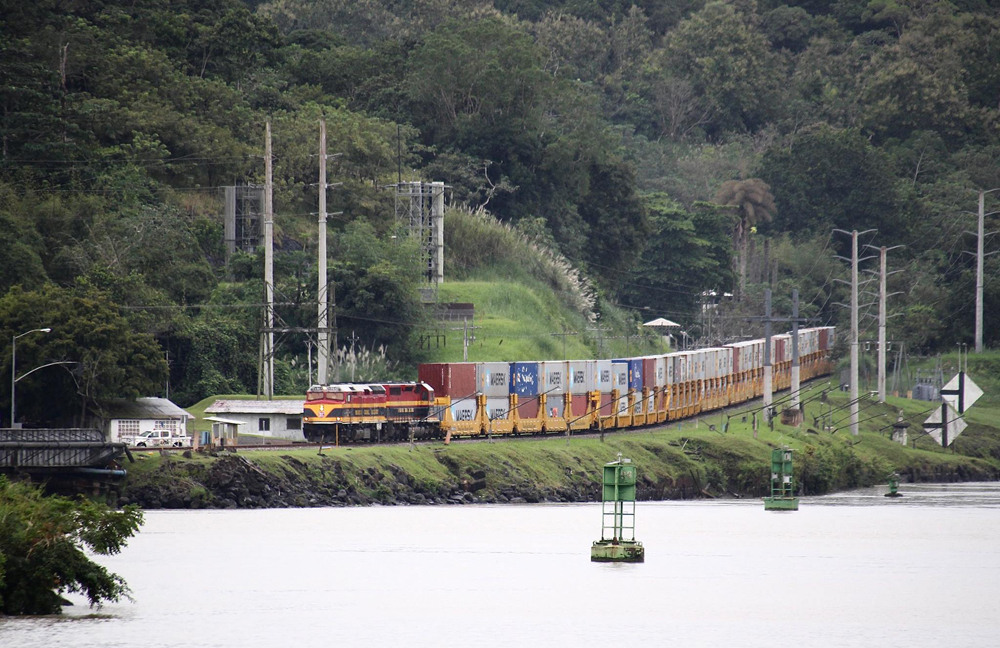
WASHINGTON — When the Surface Transportation Board names the members of its first Rail Passenger Advisory Committee, it will be worth remembering that the competition for places among the panels 18 voting members was fiercer for some seats than for others.
As outlined in the January call for nominations, the panel has a very specific makeup:
— Two representatives from Amtrak.
— Two from commuter rail operators who use facilities owned or used by Amtrak, other intercity passenger rail operators, or freight rail operators.
— Two from existing passenger rail operators other than Amtrak.
— Two from Class I freight railroads.
— Two from rail passenger advocacy organizations.
— One from a state that provides funding for intercity passenger rail.
— One from a state with intercity passenger service served only by long-distance trains.
— One from a Class II or Class III freight railroad.
— One from organized rail labor.
— One from a rail shipper or customer, or a shipper or customer advocacy organization.
— Three at-large representatives.
Based on letters posted at the STB website, by the Feb. 5 close of nominations, the board had received 92 nominations. Some were from highly qualified individuals. Others … not so much. But those nominations were far from evenly distributed among the various classifications of membership.
Amtrak’s representation? Essentially done. Amtrak president Roger Harris nominated James A. Blair, the company’s assistant vice president, host railroad, and Christopher S. Perry, associate general counsel. Presumably, the board will accept those choices; although it does have two self-nominated alternatives: George H. Luchs, an Amtrak engineer, and Fred Mattison, a system road foreman of engines for the company, who alternately would be interested in serving in an at-large capacity.
It’s those three at-large spots that have the surfeit of candidates. Of the 92 individuals nominated, 31 — just over a third — are seeking one of the at-large positions; and another six who did not specify their interest would appear to be most or solely qualified for one of those spots. Eight other people who are interested in one of the other categories also listed the at-large positions as an alternate choice.
The next largest group for nominations? Passenger advocacy organizations, with 11 (including two people from a group of seven who offered nominations in more than one category).
Interesting, the two available spots for Class I railroad representation drew nominations from just four of the six Class I railroads. And the labor and shipper-customer categories drew just two nominees each.

The STB has not yet set a date for selecting members of the committee, although the board’s spokesman said its goal is to do so as soon as possible.
The full list of nominees, by grouping:
At large (31):
— David A. Becker, retired Norfolk Southern chief engineer design & construction.
— Joseph Black, senior vice president, rail operations and service planning, WSP.
— Jonathan Broder, retired Conrail general counsel.
— Thomas C. Cornillie, owner, Transportation Research Analysis and Design Ltd.
— Ty Dragoo, Kansas Legislative director for SMART-TD.
— Aaron Edelman, general counsel, Brotherhood of Railroad Signalman.
— Carl H. Fowler, former rail travel business operator.
— Andrew Fox, 53 years in rail industry, including six years as president of Chicago South Shore & South Bend.
— Mark Grant, former chief information security officer at CSX.
— Masroor Hasan, director, Steer Group (transportation consulting).
— Tim Hoeffner, senior rail consultant, Quandel Industries.
— Barton Jennings, profession emeritus of supply chain management, Western Illinois University.
— Jester Jersey, California-based rail passenger.
— Paul Lewis, principal at rail and transit consultant DB E.C.O. North America.
— Harris Ligon, CEO, Telegraph (rail data firm).
— Patricia D. Long, president, Railway Supply Institute.
— Brian Middleton; president, Middleton Management and Consulting.
— Arthur Misiaszek, senior project engineer, Gannett Fleming.
— Roy L. Morrison, director of safety, Brotherhood of Maintenance of Way Employes Division.
— Mark Mukheji, associate director, Steer Group (transportation consulting).
— Bob O’Malley, formerly of CSX and Brightline.
— Liliana Pereira, director, Steer Group (transportation consulting).
— John Santamaria, senior vice president, Clever Devices; chair, APTA Rolling Stock Technical Committee.
— Jeffrey T. Schultz, 18 years at Washington State Department of Transportation Rail office.
— Brian P. Smith, president Smith Engineering & Associates.
— John Robert Smith, chairman, Transportation for America.
— Louis S. Thompson, retiree from World Bank and U.S. Department of Transportation.
— Arthur R. (Rob) Troup, senior vice president at transportation infrastructure firm STV.
— Paul Evan Vilter, retired from Amtrak, Conrail, CSX.
— Ripley Watson III, retired from multiple rail and media positions.
— Christopher Zappi, senior director, global strategy, Wabtec Corp.
Not specified, presumably at-large (6):
— Gregg Baxter, director, developing markets, Herzog Enterprises.
— Chris Larson, CSX conductor, not specified, presumably at-large.
— Kevin W. Sweat, director of Safety and Compliance at FMW Solutions; not indicated.
— Nicole Smullen, project manager, utility infrastructure and real estate, HNTB Corp., not specified.
— Harry Allen Weber, past president, National Railroad Historical society, former member Railroad Passsenger Car Alliance; not specified (at-large).
— Carolyn McGinn, former elected official, member of Midwest Interstate Passenger Rail Commission
Passenger advocacy organizations (9):
— B.A. Black, president, Railroad Passenger Car Alliance.
— Kevin Brubaker, deputy director, Environmental Law & Policy Center.*
— Alfred B. Craig, Jr., CEO, Transdev Rail; chair, Association of Innovative Passenger Rail Operators.
— Christopher Lau, chair of Young Professionals in Transportation International.
— Jim Mathews, CEO, Rail Passengers Association.
— Richard Rudolph, chair, Rail Users’ Network.
— Bryan Sooter, director of standards and commuter rail at the American Public Transportation Association.*
— John Webb, member, Rail Passengers Association of California and Nevada.
— Karl R. Ziebarth, member of Texas Rail Advocates.
Amtrak (4):
— James A. Blair, assistant vice president, host railroad, Amtrak
— George H. Luchs, locomotive engineer
— Fred Mattison, system road foreman of engines, Amtrak; chairman, Northeast Operating Rules Advisory Committee*
— Christpher S. Perry, associate general counsel, Amtrak.
State that provides intercity passenger funding (8):
— Michael J. Baldini, vice chair of the San Francisco Bay Area Policy Advisory Committee to the Metropolitan Transportation Commission*
— Jeffrey Davis, Rail Division director of the Texas Department of Transportation**
— Chad Edison, chief deputy secretary, rail and transit, California State Transportation Agency
— Troy Hughes, administrator of railroads, Missouri Department of Transportation.
— Richard Jankovich, rail administrator, Bureau of Public Transportation, Connecticut Department of Transportation
— Patricia Quinn, executive director, Northern New England Passenger Rail Authority
— Meredith Slesinger, rail and transit administrator, Massachusetts Department of Transportation
— DJ Stadtler, executive director, Virginia Passenger Rail Authority
State served only by long-distance trains (4):
— Shoshana Lew, executive director, Colorado Department of Transportation
— Roger Millar, Washington state Secretary of Transportation*
— Arvid Olson, director of development, Faith Ministries, Lafayette, Ind.
— David Pearce, member, Missouri Rail Passenger Advisory Committee.
Existing passenger operators other than Amtrak (1):
— Robert Padgette, managing director of California’s Capitol Corridor Joint Powers Authority *
Commuter rail operators (6):
— Richard Andreski, CEO Trinity Metro (Fort Worth, Texas).
— Jim Derwinski, CEO/Executive Director, Metra (Chicago).
— Jay Fox, executive director, Utah Transit Authority.
— David Harris, New Mexico Department of Transportation Transit and Rail Division director.
— Justin Vonashek, executive vice president, chief operating officer, Metro-North Railroad (New York).
— Lori A. Winfree, general counsel, North County Transit District (San Diego).
Class I freight railroads (4):
— Andy Daly, senior director, passenger operations, CSX Transportation.
— Adolph Gameiro, managing director, interline & network strategy, CPKC.
— Michael McClellan, senior vice president and chief strategy officer, Norfolk Southern.
— Michael Mattuecci, senior director-interline services, CN.
Class II or III freight railroads (8):
— Brian Dilger, chief financial officer, Belt Railway of Chicago.
— Alex Engelke, owner Engelke Consulting’ general manager, East Chicago Rail Terminal*
— Peter A. Gilbertson, president and CEO of Anacostia Rail Holdings.
— Eric B. Levin, Conrail vice president engineering, mechanical and real estate.
— Adam Mahlandt, general manager, Terminal Railroad Association of St. Louis.**
— Robert Ledoux, senior vice president, Florida East Coast Railway.
— Christopher Parrott, co-CEO CaterParrott Railnet.
— Carl Warren, CEO, North Carolina Railroad Co..
Rail labor (2):
— David A. Frye, vice president and Midwest regional manager of the Laborers International Union of North America.
— Greg Regan, president, Transportation Trades Department, AFL-CIO.
Rail shippers or customers (2):
— Thomas Giovinazzi, director rail services, Holcim USA.
— Jonathan R. Lamb, president, Lake Superior Warehousing Co.
Multiple categories (7):
— Husein Cumber, chief strategy officer of Florida East Coast Industries: existing intercity other than Amtrak, or developers of new intercity other than Amtrak.
— Joshua Dominic, co-founder of Dreamstar Lines: existing passenger operators other than Amtrak or developers of new intercity passenger lines.
— Barry E. Green, Rail Passengers Association member from Glendive, Mont.: representative of a state served only by long-distance trains or member of a rail passenger advocacy organization.
— Rafael S. Guroian, board member, Virginians for High Speed Rail: state-funded intercity passenger rail or rail passenger advocacy organization.
— Kim Holland, Florida DOT secretary of strategic development; state that provides funding for intercity passenger rail; commuter rail operator*
— Henry Posner III, chairman, Railroad Development Corp: developer of new intercity passenger line other than Amtrak, representative of Class II or III freight railroad, or representative of rail passenger advocacy organization*
— Knox Ross, chairman Southern Rail Commission: representative of existing passenger rail operator other than Amtrak or developer of new intercity passenger rail operator other than Amtrak.
*—Also indicated interest in at-large position.
**—No category indicated; placed in this grouping based on resume.














At the risk of (also) further offending folks on the comments’ thread, I concur with you, Mr. Landey, and your most eloquent critique of this “STB Passenger Advisory Committee.” While there is indeed a most impressive bench of qualified rail (and industry) “experts” proposed for this committee, one of whom I know personally, one still does have to wonder, at the end of the day, what this committee will ultimately accomplish and how will it be able to influence and improve our passenger rail network?
Nuff’ said …..
Andy Byford NEEDS to be an Amtrak rep, and Andy Muller of The R, BM & N should also hold a seat. He’s doing passenger rail better than most of the true passenger carriers.
I wonder why 2 reps from “Rail Shippers or Customers,” apparently freight shippers, are appropriate on a Rail Passenger Advisory Council. And it would help if there were information provided regarding some of the organizations — e.g. FMW Solutions, HNTB Corp., and what the initials stand for — e.g., WSP, DB E.C.O. North America.
HNTB is a major nationwide civil engineering design firm that has been known by its initials for many years. H stood for Howard, N for Needles, don’t recall the other letters. Chances are most current HNTB employees couldn’t tell you.
I always thought the world of HNTB, never had anything but the best to say about working with them on major projects.
I no none of these people personally, but I recognize many talented people thanks to Trains Magazine. I’m sure these nominees are able, but nothing will be accomplished by so many people. What will happen is pity parties & or mutual congratulation parties
I agree. Large groups such as what’s proposed have very little chance of being effective.
I wonder if it would bother you people if I express my dissent. On a good day, I have a well-developed dislike of committees, study groups, interest groups, etc. Most especially if sponsored by our worthless federal government.
What is to be studied and what isn’t already known? What will this group accomplish? Everyone reading these pages can name the successful passenger rail systems, and the mediocrities, and the total flops. As well, we already know the factors behind the successes, and the factors causing the other cases. It isn’t study groups.
The success of an endeavor (in this case, passenger rail) is easy to predict. It will be in inverse proportion to the number of stakeholders brought together to feel each others’ good vibrations.